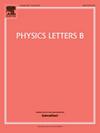Unbound neutron ν0d3/2 strength in 17C and the N=16 shell gap
IF 4.3
2区 物理与天体物理
Q1 ASTRONOMY & ASTROPHYSICS
引用次数: 0
Abstract
Significant continuum strength has been observed to be populated in 17C produced in the d(16C,p) reaction at a beam energy of 17.2 MeV/nucleon. The strength appears at greater than ∼2 MeV above the single-neutron decay threshold and has been identified as arising from transfer into the neutron orbital. Guided by shell model predictions the greater majority of the strength is associated with a 3/2+ state at an excitation energy of 4.40 MeV and a much weaker 3/2+ level at 5.60 MeV. The corresponding total widths were determined to be 3.45 and 1.6 MeV, respectively. From the backward angle proton differential cross sections and the branching ratios for neutron decay to the 16C(2) level, the corresponding spectroscopic factors to the ground state were deduced to be 0.47±10 and <0.09. Shell-model calculations employing the phenomenological SFO-tls interaction as well as Gamow Shell-Model calculations including continuum effects are in reasonable agreement with experiment, although the predicted strength lies at somewhat lower energy. The size of the N=16 shell gap () was estimated to be 5.08 MeV - some 1.3 MeV larger than found in the SFO-tls shell model calculation.
未束缚中子ν0d3/2在17C和N=16壳层间隙中的强度
在束流能量为17.2 MeV/核子时,d(16C,p)反应产生的17C中存在显著的连续统强度。强度出现在单中子衰变阈值以上,大于~ 2 MeV,并且已经确定是由于转移到中子0d3/2轨道引起的。在壳层模型预测的指导下,大多数强度与激发能为4.40−0.14+0.33 MeV的3/2+态和5.60−0.45+1.35 MeV的弱得多的3/2+态有关。相应的总宽度分别为3.45−0.78+1.82和1.6−1.4+4.6 MeV。根据后角质子微分截面和中子衰变至16C(21+)能级的分支比,推导出基态对应的光谱因子分别为0.47±10和<;0.09。采用现象学SFO-tls相互作用的壳模型计算和包括连续体效应的Gamow壳模型计算与实验结果基本一致,尽管预测的强度处于较低的能量。N=16壳层间隙(εν0d3/2 ~ εν1s1/2)的大小估计为5.08 ~ 0.33+0.43 MeV,比SFO-tls壳层模型计算结果大1.3 MeV。
本文章由计算机程序翻译,如有差异,请以英文原文为准。
求助全文
约1分钟内获得全文
求助全文
来源期刊

Physics Letters B
物理-物理:综合
CiteScore
9.10
自引率
6.80%
发文量
647
审稿时长
3 months
期刊介绍:
Physics Letters B ensures the rapid publication of important new results in particle physics, nuclear physics and cosmology. Specialized editors are responsible for contributions in experimental nuclear physics, theoretical nuclear physics, experimental high-energy physics, theoretical high-energy physics, and astrophysics.
 求助内容:
求助内容: 应助结果提醒方式:
应助结果提醒方式:


